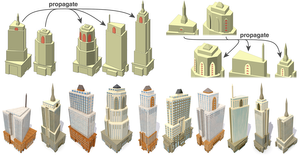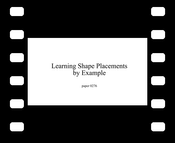Information
- Publication Type: Journal Paper with Conference Talk
- Workgroup(s)/Project(s):
- Date: August 2015
- Journal: ACM Transactions on Graphics
- Volume: 34
- Number: 4
- Location: Los Angeles, CA
- Lecturer: Paul Guerrero
- ISSN: 0730-0301
- Event: ACM SIGGRAPH 2015
- DOI: 10.1145/2766933
- Conference date: 9. August 2015 – 13. August 2015
- Pages: 108:1 – 108:13
- Keywords: modeling by example, complex model generation
Abstract
We present a method to learn and propagate shape placements in 2D polygonal scenes from a few examples provided by a user. The placement of a shape is modeled as an oriented bounding box. Simple geometric relationships between this bounding box and nearby scene polygons define a feature set for the placement. The feature sets of all example placements are then used to learn a probabilistic model over all possible placements and scenes. With this model we can generate a new set of placements with similar geometric relationships in any given scene. We introduce extensions that enable propagation and generation of shapes in 3D scenes, as well as the application of a learned modeling session to large scenes without additional user interaction. These concepts allow us to generate complex scenes with thousands of objects with relatively little user interaction.Additional Files and Images
Additional images and videos
Additional files
 additional_material:
additional material
additional_material:
additional material
 paper_lowres:
pre-print version of the paper in low resolution
paper_lowres:
pre-print version of the paper in low resolution
 paper:
pre-print version of the paper
paper:
pre-print version of the paper
Weblinks
BibTeX
@article{guerrero-2015-lsp,
title = "Learning Shape Placements by Example",
author = "Paul Guerrero and Stefan Jeschke and Michael Wimmer and
Peter Wonka",
year = "2015",
abstract = "We present a method to learn and propagate shape placements
in 2D polygonal scenes from a few examples provided by a
user. The placement of a shape is modeled as an oriented
bounding box. Simple geometric relationships between this
bounding box and nearby scene polygons define a feature set
for the placement. The feature sets of all example
placements are then used to learn a probabilistic model over
all possible placements and scenes. With this model we can
generate a new set of placements with similar geometric
relationships in any given scene. We introduce extensions
that enable propagation and generation of shapes in 3D
scenes, as well as the application of a learned modeling
session to large scenes without additional user interaction.
These concepts allow us to generate complex scenes with
thousands of objects with relatively little user
interaction.",
month = aug,
journal = "ACM Transactions on Graphics",
volume = "34",
number = "4",
issn = "0730-0301",
doi = "10.1145/2766933",
pages = "108:1--108:13",
keywords = "modeling by example, complex model generation",
URL = "https://www.cg.tuwien.ac.at/research/publications/2015/guerrero-2015-lsp/",
}


 additional_material
additional_material paper
paper video
video
